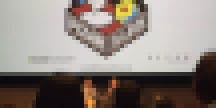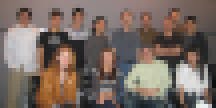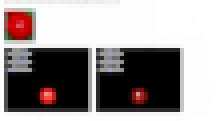Dear Mr. Catmull,
About a month ago, I watched you announce Pixar in a Box—a series of online STEM lessons and exercises developed in partnership with Khan Academy—onstage with Sal Khan at the beautiful Pixar Studios in Emeryville, CA. Walking through the magnificent main atrium, which was currently dressed in an Inside Out theme, I was struck with a deep feeling of nostalgia. I must admit that I was especially excited to learn that you were taking this foray into education technology because, after all, you are the reason that I entered this industry.

The first time I applied to Pixar, I was rejected. It was 2007, my senior year at Cal. After wandering through most of my upper-division Computer Science classes, in my last semester I decided to take CS184 (Computer Graphics) with Professor Barsky despite barely passing Math 54 (linear algebra, differential equations) my freshman year. I loved it! Finally, a CS subject I was actually good at. The class projects were group projects, but I did them on my own and got As on all of them.
Pixar recruiters came by around March and many of us in the class eagerly applied; Pixar was, and still is, the gold standard for graphics nerds. My interviewer was Technical Director, Tom Sanocki and it was clear in the first 10 minutes that he was not impressed with my half-semester of computer graphics work (also, that I didn’t know what a Technical Director was). The interview was set for half an hour, so I spent the rest of the interview asking Tom what it was like working at Pixar and what he thought my resume was lacking. He said I needed more experience and better content in my portfolio (also not impressed by my amateur photography).
Graduation came and went and working at Pixar was still my dream job. I spent that summer in Irvine sleeping on my friend's couch, searching various university computer science course pages for online lecture slides (which were rare back then, but CS professors are generally ahead of the technology adoption curve). I studied slides from Stanford, MIT and CMU, and attempted to do their projects on my own. I built a simple Ray Tracer as an undergrad (spheres, multiple reflections, point lights, shadows), but the CMU ray tracer project had a long list of optional features (polygons, texture maps, lens effects, depth of field, etc.), which then I researched and added onto my original ray tracer.
If only Pixar in a Box were around in 2007...

During that summer, I also bought every Pixar DVD I didn’t already own and watched each repeatedly, including every single behind-the-scenes, making-of, and director's-commentary extra feature. By the end of that summer, I not only had a portfolio full of quality ray-traced renders, but also I knew what people at Pixar cared about, how they worked, the words they used, and I definitely, definitely knew what a TD was. When a Production Engineering internship opened up that September, I quickly applied and after a few interviews got in the door.
My first two weeks of work were spent in PU ( Pixar University) Bootcamp where I was given a crash course on the Pixar production pipeline: modeling in Maya, rigging, shading, set decoration, lighting, animation, and camera work in MENV, and shipping clips to the render farm to be rendered. The final project was to use all this knowledge to create a short animated clip featuring Luxo Jr. and his iconic ball.
Even after graduating from PU Bootcamp, I was encouraged to spend around 10% of my working time (4 hours per week) taking other PU classes. I took full advantage of this, and enrolled in classes in lighting, shading, Python, 2D animation, figure drawing and live action filmmaking. The Pixar University program, pulled straight from Disney, was easily the most enriching part of my internship and exemplified Pixar’s commitment to cross-departmental professional development. I continue to use these lessons learned throughout my career.
Another part of Pixar’s internship program was bi-weekly lunches where representatives from different departments would chat with interns about their work. During one such lunch we were lucky enough to have you, Ed Catmull, founder and President of Pixar, come talk to us. I sat as close to you as possible and I remember you would fiddle absent-mindedly with your ring while you spoke. Seeing you on-stage with Sal Khan, I was tickled to notice that you still do this.

I remember you as a pragmatic and dispassionate speaker. During my internship, I was constantly surrounded by pixie dust and magic and it was difficult not to get caught up in the mystique, but you maintained a composed and unaffected demeanor throughout the lunch. That day you changed my life with this cynical, but logical observation: Pixar makes family films because it’s the only film genre that is profitable enough to cover the costs of an animation studio.
Mind. Blown.
The example you gave was the film, No Country for Old Men, which that year won the Academy Award for Best Picture and earned $170 million at the box office, versus Shrek the Third, which earned $800 million and was eminently forgettable. It was clear to me, in the infinite wisdom that comes with being 22-years-old, that since parents probably weren’t spending money on sports cars and Caribbean cruises that they would instead be willing to invest copious amounts of cash into their children’s entertainment and education—I was sure I’d cracked the market. So, once my internship concluded, I left Pixar to build a math game with my friends.
But that’s a story for another time.
Pixar in a Box
Back to Pixar in a Box. I have read plenty over the years about Khan Academy, but never actually used it until loading up Pixar in a Box. The landing page displayed a multitude of computer graphics topics and I couldn’t wait to get started!
I began by skimming through a few of the early topics. I like that the first lesson was led by Tony DeRose (with whom you share an Academy Award) and the second covered your subdivision algorithm. I can feel your heart in Pixar in a Box, Mr. Catmull.
The video lessons are short — only 2-3 minutes each — but extremely charming, and the quirkiness of Pixar really shines through. Pixar’s company culture is one of manic attention to detail and constant plussing. Computer animation is an arduous process, and it takes a certain kind of crazy to enjoy it. The people at Pixar are the best of the best, and also perhaps the craziest of the craziest. Each lesson is presented clearly and logically with all the playful precision of Pixar and none of the slick charisma of Sal Khan. Maybe I’m a little crazy too, but I loved each and every one.
I consider myself pretty decent at math and I have prior experience with computer graphics topics so I thought I’d breeze through the problems. Not so. Some of these problems were extremely frustrating. The worst were those with subjective criteria like the lighting problems in the Rendering 101 course (content designed for “all ages”). I understand that the billiard ball has both specular and diffuse shader properties while the tennis ball has only diffuse but I still got problems wrong because of the selectively finicky grader. This wouldn’t be so bad except you must get five correct answers in a row to earn a completion mark for the lesson—no fun.

Wait. On second thought, maybe these problems are brilliant.
As much as one might believe working at Pixar to be a constant stream of delightfully whimsical activities, again I must stress, computer animation is an ARDUOUS process. You spend hours, days, weeks obsessing over the tiniest details and, if you do your job correctly, no one in the audience notices them at all. There was a running joke at Pixar that people are always excited to learn you work at Pixar but lose interest when you tell them what you actually do (so… you’re not an animator?). Every time the Khan Academy grader rejects your submission, imagine it’s the finicky director rejecting your tennis ball shader while spluttering, “No, no, no, that glow is ALL wrong!” In a way, even the most frustrating problems in Pixar in a Box might reflect what it takes to work on the technical aspects of a Pixar film.
I found the “advanced high school level” Mathematics of Rendering problems to be much easier, but less interesting than the “all ages” Rendering 101. These problems were not subjective, and boiled down to fairly complex, but straight-forward, algebra. Each question took a while to solve, and the five-in-a-row-correct passing requirement made me sweat on every fifth problem, but it really wasn’t too bad.

This is the kind of math that is vitally important to understand in computer graphics. I, too once implemented the ray/plane intersection algorithm (albeit with a different formula). Of course, after you code it once, you likely don’t have to think about the formula very often.

So, once someone finishes the coursework, what next? How would one move from Pixar in a Box to paycheck in the mailbox? I think, and Mr. Catmull hopefully you agree, that one just needs a single practical skill. Just one. That skill can be anything from coding, stop-motion animation, sculpture, photography, video production, sound design, painting—really the sky’s the limit. If you are a talented photographer who has completed and fully understood the Pixar in a Box coursework, you’ve got a great chance of landing that dream job at Pixar.
(Disclaimer: If your dreams involve solving very long algebra problems all day, you might be crazy enough to work at Pixar)
I don’t know how Pixar in a Box compares to other content on Khan Academy, but I found it to be a delightful presentation of the often esoteric field of computer graphics. This is not the type of product that typically gets a lot of press after it’s launch, but the inspired individuals who are truly dedicated to making their way into the amazing company you started nearly 30 years ago will find their way to it.
Mr. Catmull, over the years, I’ve thought of many questions I’d like to ask you about computer graphics, edtech, and building content for the family audience, but last month when I met you for the second time, I could only manage to shake your hand, ask for a picture and smile like a doofus. Thanks for continuing to inspire me, even seven years later.
Sincerely,
Brady Fukumoto



